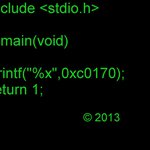The official Mbed 2 C/C++ SDK provides the software platform and libraries to build your applications.
Dependents: hello SerialTestv11 SerialTestv12 Sierpinski ... more
mbed 2
This is the mbed 2 library. If you'd like to learn about Mbed OS please see the mbed-os docs.
TARGET_MIMXRT1050_EVK/TOOLCHAIN_IAR/fsl_pmu.h
- Committer:
- AnnaBridge
- Date:
- 2019-02-20
- Revision:
- 172:65be27845400
- Parent:
- 171:3a7713b1edbc
File content as of revision 172:65be27845400:
/*
* The Clear BSD License
* Copyright (c) 2016, Freescale Semiconductor, Inc.
* Copyright 2016-2017 NXP
* All rights reserved.
*
* Redistribution and use in source and binary forms, with or without modification,
* are permitted (subject to the limitations in the disclaimer below) provided
* that the following conditions are met:
*
* o Redistributions of source code must retain the above copyright notice, this list
* of conditions and the following disclaimer.
*
* o Redistributions in binary form must reproduce the above copyright notice, this
* list of conditions and the following disclaimer in the documentation and/or
* other materials provided with the distribution.
*
* o Neither the name of the copyright holder nor the names of its
* contributors may be used to endorse or promote products derived from this
* software without specific prior written permission.
*
* NO EXPRESS OR IMPLIED LICENSES TO ANY PARTY'S PATENT RIGHTS ARE GRANTED BY THIS LICENSE.
* THIS SOFTWARE IS PROVIDED BY THE COPYRIGHT HOLDERS AND CONTRIBUTORS "AS IS" AND
* ANY EXPRESS OR IMPLIED WARRANTIES, INCLUDING, BUT NOT LIMITED TO, THE IMPLIED
* WARRANTIES OF MERCHANTABILITY AND FITNESS FOR A PARTICULAR PURPOSE ARE
* DISCLAIMED. IN NO EVENT SHALL THE COPYRIGHT HOLDER OR CONTRIBUTORS BE LIABLE FOR
* ANY DIRECT, INDIRECT, INCIDENTAL, SPECIAL, EXEMPLARY, OR CONSEQUENTIAL DAMAGES
* (INCLUDING, BUT NOT LIMITED TO, PROCUREMENT OF SUBSTITUTE GOODS OR SERVICES;
* LOSS OF USE, DATA, OR PROFITS; OR BUSINESS INTERRUPTION) HOWEVER CAUSED AND ON
* ANY THEORY OF LIABILITY, WHETHER IN CONTRACT, STRICT LIABILITY, OR TORT
* (INCLUDING NEGLIGENCE OR OTHERWISE) ARISING IN ANY WAY OUT OF THE USE OF THIS
* SOFTWARE, EVEN IF ADVISED OF THE POSSIBILITY OF SUCH DAMAGE.
*/
#ifndef _FSL_PMU_H_
#define _FSL_PMU_H_
#include "fsl_common.h"
/*! @addtogroup pmu */
/*! @{ */
/*******************************************************************************
* Definitions
******************************************************************************/
/*! @name Driver version */
/*@{*/
/*! @brief PMU driver version */
#define FSL_PMU_DRIVER_VERSION (MAKE_VERSION(2, 0, 0)) /*!< Version 2.0.0. */
/*@}*/
/*!
* @brief Status flags.
*/
enum _pmu_status_flags
{
kPMU_1P1RegulatorOutputOK = (1U << 0U), /*!< Status bit that signals when the 1p1 regulator output
is ok. 1 = regulator output > brownout target. */
kPMU_1P1BrownoutOnOutput = (1U << 1U), /*!< Status bit that signals when a 1p1 brownout is detected
on the regulator output. */
kPMU_3P0RegulatorOutputOK = (1U << 2U), /*!< Status bit that signals when the 3p0 regulator output
is ok. 1 = regulator output > brownout target. */
kPMU_3P0BrownoutOnOutput = (1U << 3U), /*!< Status bit that signals when a 3p0 brownout is detected
on the regulator output. */
kPMU_2P5RegulatorOutputOK = (1U << 4U), /*!< Status bit that signals when the 2p5 regulator output
is ok. 1 = regulator output > brownout target. */
kPMU_2P5BrownoutOnOutput = (1U << 5U), /*!< Status bit that signals when a 2p5 brownout is detected
on the regulator output. */
};
/*!
* @brief The source for the reference voltage of the weak 1P1 regulator.
*/
typedef enum _pmu_1p1_weak_reference_source
{
kPMU_1P1WeakReferenceSourceAlt0 = 0U, /*!< Weak-linreg output tracks low-power-bandgap voltage. */
kPMU_1P1WeakReferenceSourceAlt1 = 1U, /*!< Weak-linreg output tracks VDD_SOC_CAP voltage. */
} pmu_1p1_weak_reference_source_t;
/*!
* @brief Input voltage source for LDO_3P0 from USB VBus.
*/
typedef enum _pmu_3p0_vbus_voltage_source
{
kPMU_3P0VBusVoltageSourceAlt0 = 0U, /*!< USB_OTG1_VBUS - Utilize VBUS OTG1 for power. */
kPMU_3P0VBusVoltageSourceAlt1 = 1U, /*!< USB_OTG2_VBUS - Utilize VBUS OTG2 for power. */
} pmu_3p0_vbus_voltage_source_t;
/*!
* @brief Regulator voltage ramp rate.
*/
typedef enum _pmu_core_reg_voltage_ramp_rate
{
kPMU_CoreRegVoltageRampRateFast = 0U, /*!< Fast. */
kPMU_CoreRegVoltageRampRateMediumFast = 1U, /*!< Medium Fast. */
kPMU_CoreRegVoltageRampRateMediumSlow = 2U, /*!< Medium Slow. */
kPMU_CoreRegVoltageRampRateSlow = 0U, /*!< Slow. */
} pmu_core_reg_voltage_ramp_rate_t;
#if defined(FSL_FEATURE_PMU_HAS_LOWPWR_CTRL) && FSL_FEATURE_PMU_HAS_LOWPWR_CTRL
/*!
* @brief Mask values of power gate.
*/
enum _pmu_power_gate
{
kPMU_PowerGateDisplay = PMU_LOWPWR_CTRL_MIX_PWRGATE_MASK, /*!< Display power gate control. */
kPMU_PowerGateDisplayLogic = PMU_LOWPWR_CTRL_DISPLAY_PWRGATE_MASK, /*!< Display logic power gate control. */
kPMU_PowerGateL2 = PMU_LOWPWR_CTRL_L2_PWRGATE_MASK, /*!< L2 power gate control. */
kPMU_PowerGateL1 = PMU_LOWPWR_CTRL_L1_PWRGATE_MASK, /*!< L1 power gate control. */
kPMU_PowerGateRefTopIBias = PMU_LOWPWR_CTRL_REFTOP_IBIAS_OFF_MASK, /*!< Low power reftop ibias disable. */
};
#endif /* FSL_FEATURE_PMU_HAS_LOWPWR_CTRL. */
/*!
* @brief Bandgap select.
*/
typedef enum _pmu_power_bandgap
{
kPMU_NormalPowerBandgap = 0U, /*!< Normal power bandgap. */
kPMU_LowPowerBandgap = 1U, /*!< Low power bandgap. */
} pmu_power_bandgap_t;
/*******************************************************************************
* API
******************************************************************************/
#if defined(__cplusplus)
extern "C" {
#endif /* __cplusplus*/
/*!
* @name Status.
* @{
*/
uint32_t PMU_GetStatusFlags(PMU_Type *base);
/*@}*/
/*!
* @name 1P1 Regular
* @{
*/
/*!
* @brief Selects the source for the reference voltage of the weak 1P1 regulator.
*
* @param base PMU peripheral base address.
* @param option The option for reference voltage source, see to #pmu_1p1_weak_reference_source_t.
*/
static inline void PMU_1P1SetWeakReferenceSource(PMU_Type *base, pmu_1p1_weak_reference_source_t option)
{
base->REG_1P1 = (base->REG_1P1 & ~PMU_REG_1P1_SELREF_WEAK_LINREG_MASK) | PMU_REG_1P1_SELREF_WEAK_LINREG(option);
}
/*!
* @brief Enables the weak 1P1 regulator.
*
* This regulator can be used when the main 1P1 regulator is disabled, under low-power conditions.
*
* @param base PMU peripheral base address.
* @param enable Enable the feature or not.
*/
static inline void PMU_1P1EnableWeakRegulator(PMU_Type *base, bool enable)
{
if (enable)
{
base->REG_1P1 |= PMU_REG_1P1_ENABLE_WEAK_LINREG_MASK;
}
else
{
base->REG_1P1 &= ~PMU_REG_1P1_ENABLE_WEAK_LINREG_MASK;
}
}
/*!
* @brief Adjust the 1P1 regulator output voltage.
*
* Each LSB is worth 25mV. Programming examples are detailed below. Other output target voltages
* may be interpolated from these examples. Choices must be in this range:
* - 0x1b(1.375V) >= output_trg >= 0x04(0.8V)
* - 0x04 : 0.8V
* - 0x10 : 1.1V (typical)
* - 0x1b : 1.375V
* NOTE: There may be reduced chip functionality or reliability at the extremes of the programming range.
*
* @param base PMU peripheral base address.
* @param value Setting value for the output.
*/
static inline void PMU_1P1SetRegulatorOutputVoltage(PMU_Type *base, uint32_t value)
{
base->REG_1P1 = (base->REG_1P1 & ~PMU_REG_1P1_OUTPUT_TRG_MASK) | PMU_REG_1P1_OUTPUT_TRG(value);
}
/*!
* @brief Adjust the 1P1 regulator brownout offset voltage.
*
* Control bits to adjust the regulator brownout offset voltage in 25mV steps. The reset
* brown-offset is 175mV below the programmed target code.
* Brownout target = OUTPUT_TRG - BO_OFFSET.
* Some steps may be irrelevant because of input supply limitations or load operation.
*
* @param base PMU peripheral base address.
* @param value Setting value for the brownout offset. The available range is in 3-bit.
*/
static inline void PMU_1P1SetBrownoutOffsetVoltage(PMU_Type *base, uint32_t value)
{
base->REG_1P1 = (base->REG_1P1 & ~PMU_REG_1P1_BO_OFFSET_MASK) | PMU_REG_1P1_BO_OFFSET(value);
}
/*!
* @brief Enable the pull-down circuitry in the regulator.
*
* @param base PMU peripheral base address.
* @param enable Enable the feature or not.
*/
static inline void PMU_1P1EnablePullDown(PMU_Type *base, bool enable)
{
if (enable)
{
base->REG_1P1 |= PMU_REG_1P1_ENABLE_PULLDOWN_MASK;
}
else
{
base->REG_1P1 &= ~PMU_REG_1P1_ENABLE_PULLDOWN_MASK;
}
}
/*!
* @brief Enable the current-limit circuitry in the regulator.
*
* @param base PMU peripheral base address.
* @param enable Enable the feature or not.
*/
static inline void PMU_1P1EnableCurrentLimit(PMU_Type *base, bool enable)
{
if (enable)
{
base->REG_1P1 |= PMU_REG_1P1_ENABLE_ILIMIT_MASK;
}
else
{
base->REG_1P1 &= ~PMU_REG_1P1_ENABLE_ILIMIT_MASK;
}
}
/*!
* @brief Enable the brownout circuitry in the regulator.
*
* @param base PMU peripheral base address.
* @param enable Enable the feature or not.
*/
static inline void PMU_1P1EnableBrownout(PMU_Type *base, bool enable)
{
if (enable)
{
base->REG_1P1 |= PMU_REG_1P1_ENABLE_BO_MASK;
}
else
{
base->REG_1P1 &= ~PMU_REG_1P1_ENABLE_BO_MASK;
}
}
/*!
* @brief Enable the regulator output.
*
* @param base PMU peripheral base address.
* @param enable Enable the feature or not.
*/
static inline void PMU_1P1EnableOutput(PMU_Type *base, bool enable)
{
if (enable)
{
base->REG_1P1 |= PMU_REG_1P1_ENABLE_LINREG_MASK;
}
else
{
base->REG_1P1 &= ~PMU_REG_1P1_ENABLE_LINREG_MASK;
}
}
/*@}*/
/*!
* @name 3P0 Regular
* @{
*/
/*!
* @brief Adjust the 3P0 regulator output voltage.
*
* Each LSB is worth 25mV. Programming examples are detailed below. Other output target voltages
* may be interpolated from these examples. Choices must be in this range:
* - 0x00(2.625V) >= output_trg >= 0x1f(3.4V)
* - 0x00 : 2.625V
* - 0x0f : 3.0V (typical)
* - 0x1f : 3.4V
*
* @param base PMU peripheral base address.
* @param value Setting value for the output.
*/
static inline void PMU_3P0SetRegulatorOutputVoltage(PMU_Type *base, uint32_t value)
{
base->REG_3P0 = (base->REG_3P0 & ~PMU_REG_3P0_OUTPUT_TRG_MASK) | PMU_REG_3P0_OUTPUT_TRG(value);
}
/*!
* @brief Select input voltage source for LDO_3P0.
*
* Select input voltage source for LDO_3P0 from either USB_OTG1_VBUS or USB_OTG2_VBUS. If only
* one of the two VBUS voltages is present, it is automatically selected.
*
* @param base PMU peripheral base address.
* @param option User-defined input voltage source for LDO_3P0.
*/
static inline void PMU_3P0SetVBusVoltageSource(PMU_Type *base, pmu_3p0_vbus_voltage_source_t option)
{
base->REG_3P0 = (base->REG_3P0 & ~PMU_REG_3P0_VBUS_SEL_MASK) | PMU_REG_3P0_VBUS_SEL(option);
}
/*!
* @brief Adjust the 3P0 regulator brownout offset voltage.
*
* Control bits to adjust the 3P0 regulator brownout offset voltage in 25mV steps. The reset
* brown-offset is 175mV below the programmed target code.
* Brownout target = OUTPUT_TRG - BO_OFFSET.
* Some steps may be irrelevant because of input supply limitations or load operation.
*
* @param base PMU peripheral base address.
* @param value Setting value for the brownout offset. The available range is in 3-bit.
*/
static inline void PMU_3P0SetBrownoutOffsetVoltage(PMU_Type *base, uint32_t value)
{
base->REG_3P0 = (base->REG_3P0 & ~PMU_REG_3P0_BO_OFFSET_MASK) | PMU_REG_3P0_BO_OFFSET(value);
}
/*!
* @brief Enable the current-limit circuitry in the 3P0 regulator.
*
* @param base PMU peripheral base address.
* @param enable Enable the feature or not.
*/
static inline void PMU_3P0EnableCurrentLimit(PMU_Type *base, bool enable)
{
if (enable)
{
base->REG_3P0 |= PMU_REG_3P0_ENABLE_ILIMIT_MASK;
}
else
{
base->REG_3P0 &= ~PMU_REG_3P0_ENABLE_ILIMIT_MASK;
}
}
/*!
* @brief Enable the brownout circuitry in the 3P0 regulator.
*
* @param base PMU peripheral base address.
* @param enable Enable the feature or not.
*/
static inline void PMU_3P0EnableBrownout(PMU_Type *base, bool enable)
{
if (enable)
{
base->REG_3P0 |= PMU_REG_3P0_ENABLE_BO_MASK;
}
else
{
base->REG_3P0 &= ~PMU_REG_3P0_ENABLE_BO_MASK;
}
}
/*!
* @brief Enable the 3P0 regulator output.
*
* @param base PMU peripheral base address.
* @param enable Enable the feature or not.
*/
static inline void PMU_3P0EnableOutput(PMU_Type *base, bool enable)
{
if (enable)
{
base->REG_3P0 |= PMU_REG_3P0_ENABLE_LINREG_MASK;
}
else
{
base->REG_3P0 &= ~PMU_REG_3P0_ENABLE_LINREG_MASK;
}
}
/* @} */
/*!
* @name 2P5 Regulator
* @{
*/
/*!
* @brief Enables the weak 2P5 regulator.
*
* This low power regulator is used when the main 2P5 regulator is disabled
* to keep the 2.5V output roughly at 2.5V. Scales directly with the value of VDDHIGH_IN.
*
* @param base PMU peripheral base address.
* @param enable Enable the feature or not.
*/
static inline void PMU_2P5EnableWeakRegulator(PMU_Type *base, bool enable)
{
if (enable)
{
base->REG_2P5 |= PMU_REG_2P5_ENABLE_WEAK_LINREG_MASK;
}
else
{
base->REG_2P5 &= ~PMU_REG_2P5_ENABLE_WEAK_LINREG_MASK;
}
}
/*!
* @brief Adjust the 1P1 regulator output voltage.
*
* Each LSB is worth 25mV. Programming examples are detailed below. Other output target voltages
* may be interpolated from these examples. Choices must be in this range:
* - 0x00(2.1V) >= output_trg >= 0x1f(2.875V)
* - 0x00 : 2.1V
* - 0x10 : 2.5V (typical)
* - 0x1f : 2.875V
* NOTE: There may be reduced chip functionality or reliability at the extremes of the programming range.
*
* @param base PMU peripheral base address.
* @param value Setting value for the output.
*/
static inline void PMU_2P5SetRegulatorOutputVoltage(PMU_Type *base, uint32_t value)
{
base->REG_2P5 = (base->REG_2P5 & ~PMU_REG_2P5_OUTPUT_TRG_MASK) | PMU_REG_2P5_OUTPUT_TRG(value);
}
/*!
* @brief Adjust the 2P5 regulator brownout offset voltage.
*
* Adjust the regulator brownout offset voltage in 25mV steps. The reset
* brown-offset is 175mV below the programmed target code.
* Brownout target = OUTPUT_TRG - BO_OFFSET.
* Some steps may be irrelevant because of input supply limitations or load operation.
*
* @param base PMU peripheral base address.
* @param value Setting value for the brownout offset. The available range is in 3-bit.
*/
static inline void PMU_2P5SetBrownoutOffsetVoltage(PMU_Type *base, uint32_t value)
{
base->REG_2P5 = (base->REG_2P5 & ~PMU_REG_2P5_BO_OFFSET_MASK) | PMU_REG_2P5_BO_OFFSET(value);
}
/*!
* @brief Enable the pull-down circuitry in the 2P5 regulator.
*
* @param base PMU peripheral base address.
* @param enable Enable the feature or not.
*/
static inline void PMU_2P5EnablePullDown(PMU_Type *base, bool enable)
{
if (enable)
{
base->REG_2P5 |= PMU_REG_2P5_ENABLE_PULLDOWN_MASK;
}
else
{
base->REG_2P5 &= ~PMU_REG_2P5_ENABLE_PULLDOWN_MASK;
}
}
/*!
* @brief Enable the pull-down circuitry in the 2P5 regulator.
* @deprecated Do not use this function. It has been superceded by @ref PMU_2P5EnablePullDown.
*/
static inline void PMU_2P1EnablePullDown(PMU_Type *base, bool enable)
{
if (enable)
{
base->REG_2P5 |= PMU_REG_2P5_ENABLE_PULLDOWN_MASK;
}
else
{
base->REG_2P5 &= ~PMU_REG_2P5_ENABLE_PULLDOWN_MASK;
}
}
/*!
* @brief Enable the current-limit circuitry in the 2P5 regulator.
*
* @param base PMU peripheral base address.
* @param enable Enable the feature or not.
*/
static inline void PMU_2P5EnableCurrentLimit(PMU_Type *base, bool enable)
{
if (enable)
{
base->REG_2P5 |= PMU_REG_2P5_ENABLE_ILIMIT_MASK;
}
else
{
base->REG_2P5 &= ~PMU_REG_2P5_ENABLE_ILIMIT_MASK;
}
}
/*!
* @brief Enable the brownout circuitry in the 2P5 regulator.
*
* @param base PMU peripheral base address.
* @param enable Enable the feature or not.
*/
static inline void PMU_2P5nableBrownout(PMU_Type *base, bool enable)
{
if (enable)
{
base->REG_2P5 |= PMU_REG_2P5_ENABLE_BO_MASK;
}
else
{
base->REG_2P5 &= ~PMU_REG_2P5_ENABLE_BO_MASK;
}
}
/*!
* @brief Enable the 2P5 regulator output.
*
* @param base PMU peripheral base address.
* @param enable Enable the feature or not.
*/
static inline void PMU_2P5EnableOutput(PMU_Type *base, bool enable)
{
if (enable)
{
base->REG_2P5 |= PMU_REG_2P5_ENABLE_LINREG_MASK;
}
else
{
base->REG_2P5 &= ~PMU_REG_2P5_ENABLE_LINREG_MASK;
}
}
/* @} */
/*!
* @name Core Regulator
* @{
*/
/*!
* @brief Increase the gate drive on power gating FETs.
*
* If set, increases the gate drive on power gating FETs to reduce leakage in the off state.
* Care must be taken to apply this bit only when the input supply voltage to the power FET
* is less than 1.1V.
* NOTE: This bit should only be used in low-power modes where the external input supply voltage
* is nominally 0.9V.
*
* @param base PMU peripheral base address.
* @param enable Enable the feature or not.
*/
static inline void PMU_CoreEnableIncreaseGateDrive(PMU_Type *base, bool enable)
{
if (enable)
{
base->REG_CORE |= PMU_REG_CORE_FET_ODRIVE_MASK;
}
else
{
base->REG_CORE &= ~PMU_REG_CORE_FET_ODRIVE_MASK;
}
}
/*!
* @brief Set the CORE regulator voltage ramp rate.
*
* @param base PMU peripheral base address.
* @param option User-defined option for voltage ramp rate, see to #pmu_core_reg_voltage_ramp_rate_t.
*/
static inline void PMU_CoreSetRegulatorVoltageRampRate(PMU_Type *base, pmu_core_reg_voltage_ramp_rate_t option)
{
base->REG_CORE = (base->REG_CORE & ~PMU_REG_CORE_RAMP_RATE_MASK) | PMU_REG_CORE_RAMP_RATE(option);
}
/*!
* @brief Define the target voltage for the SOC power domain.
*
* Define the target voltage for the SOC power domain. Single-bit increments reflect 25mV core
* voltage steps. Some steps may not be relevant because of input supply limitations or load operation.
* - 0x00 : Power gated off.
* - 0x01 : Target core voltage = 0.725V
* - 0x02 : Target core voltage = 0.750V
* - ...
* - 0x10 : Target core voltage = 1.100V
* - ...
* - 0x1e : Target core voltage = 1.450V
* - 0x1F : Power FET switched full on. No regulation.
* NOTE: This register is capable of programming an over-voltage condition on the device. Consult the
* datasheet Operating Ranges table for the allowed voltages.
*
* @param base PMU peripheral base address.
* @param value Setting value for target voltage. 5-bit available
*/
static inline void PMU_CoreSetSOCDomainVoltage(PMU_Type *base, uint32_t value)
{
base->REG_CORE = (base->REG_CORE & ~PMU_REG_CORE_REG2_TARG_MASK) | PMU_REG_CORE_REG2_TARG(value);
}
/*!
* @brief Define the target voltage for the ARM Core power domain.
*
* Define the target voltage for the ARM Core power domain. Single-bit increments reflect 25mV core
* voltage steps. Some steps may not be relevant because of input supply limitations or load operation.
* - 0x00 : Power gated off.
* - 0x01 : Target core voltage = 0.725V
* - 0x02 : Target core voltage = 0.750V
* - ...
* - 0x10 : Target core voltage = 1.100V
* - ...
* - 0x1e : Target core voltage = 1.450V
* - 0x1F : Power FET switched full on. No regulation.
* NOTE: This register is capable of programming an over-voltage condition on the device. Consult the
* datasheet Operating Ranges table for the allowed voltages.
*
* @param base PMU peripheral base address.
* @param value Setting value for target voltage. 5-bit available
*/
static inline void PMU_CoreSetARMCoreDomainVoltage(PMU_Type *base, uint32_t value)
{
base->REG_CORE = (base->REG_CORE & ~PMU_REG_CORE_REG0_TARG_MASK) | PMU_REG_CORE_REG0_TARG(value);
}
/* @} */
#if defined(FSL_FEATURE_PMU_HAS_LOWPWR_CTRL) && FSL_FEATURE_PMU_HAS_LOWPWR_CTRL
/*!
* @name Power Gate Controller & other
* @{
*/
/*!
* @brief Gate the power to modules.
*
* @param base PMU peripheral base address.
* @param gates Mask value for the module to be gated. See to #_pmu_power_gate.
*/
static inline void PMU_GatePower(PMU_Type *base, uint32_t gates)
{
base->LOWPWR_CTRL_SET = gates;
}
/*!
* @brief Ungate the power to modules.
*
* @param base PMU peripheral base address.
* @param gates Mask value for the module to be gated. See to #_pmu_power_gate.
*/
static inline void PMU_UngatePower(PMU_Type *base, uint32_t gates)
{
base->LOWPWR_CTRL_CLR = gates;
}
/*!
* @brief Enable the low power bandgap.
*
* @param base PMU peripheral base address.
* @param enable Enable the low power bandgap or use the normal power bandgap.
* @
*/
static inline void PMU_EnableLowPowerBandgap(PMU_Type *base, bool enable)
{
if (enable)
{
base->LOWPWR_CTRL_SET = PMU_LOWPWR_CTRL_LPBG_SEL_MASK; /* Use the low power bandgap. */
}
else
{
base->LOWPWR_CTRL_CLR = PMU_LOWPWR_CTRL_LPBG_SEL_MASK; /* Use the normal power bandgap. */
}
}
#endif /* FSL_FEATURE_PMU_HAS_LOWPWR_CTRL. */
/* @} */
#if defined(__cplusplus)
}
#endif /* __cplusplus*/
/*! @}*/
#endif /* _FSL_PMU_H_*/
 mbed official
mbed official




